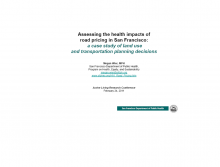We are pleased to announce an exciting new alliance between Active Living Research and GP RED to co-host and coordinate...
Assessing the Health Impacts of Road Pricing in San Francisco: A Case Study of Land Use and Transportation Planning Decisions

Presentation at the 2011 Active Living Research Annual Conference
Background:
Consideration of health impacts of road pricing proposals - which charge drivers in specific areas or roadways - are largely absent from policy debates in the United States, despite potential health benefits or harms from changes in active transportation, air pollutants, traffic-related noise, and collisions, or inequitable impacts. These debates typically focus on immediate concerns for businesses and drivers or longer-term environmental goals, and not health impacts - which can be more tangible and immediate. Health impact assessment (HIA) can make health benefits and costs more transparent, allowing them to be included in policy calculus and for mitigation of adverse impacts.
The San Francisco County Transportation Authority (SFCTA) is studying the feasibility of congestion pricing for downtown San Francisco (SF). A $3 fee would be charged during peak commute periods, with revenue invested in transportation and public realm programs. The study includes economic, environmental, equity, and transportation system performance impacts. The San Francisco Department of Public Health (SFDPH) is conducting an HIA of the proposed policy, using SFCTA study outputs as HIA inputs, and consulting with transportation, economics, and injury prevention experts and diverse stakeholders representing environmental justice, neighborhood, business, and transportation concerns.
Objectives:
HIA objectives are to: scope priority health issues related to the proposed road pricing scheme with local stakeholders; identify best available analytic methods; analyze and document baseline health conditions; make evidence-based judgments of potential health impacts; and recommend policy modifications based on HIA findings.
Methods:
Based on feedback from an ongoing community stakeholder scoping process, SFDPH is using the following methods to assess existing conditions and quantify policy impacts on physical activity, traffic-related injuries, and health outcomes associated with traffic-related air pollution and noise.
The SFCTA is providing data on existing and future trips by travel mode (auto/transit/walk/bike) and distance from their transportation model. SFDPH is also conducting pedestrian/bicyclist counts at select locations. We are using a pedestrian/bicyclist volume forecasting approach and data collected with the Pedestrian Environmental Quality Index, an observational survey tool developed by SFDPH including 30 physical street features, to assess policy impacts on active transportation.
SFDPH is analyzing publicly available data on pedestrian/bicycle injury collisions, and modeling future changes using a multivariate forecasting approach with inputs from the SFCTA and other socio-demographic and built environment area characteristics. The SF Injury Center is providing hospital cost data to estimate economic impacts of injuries. SFDPH is estimating baseline/future air pollution exposure using dispersion modeling of roadway-related particulate matter, nitrogen oxide, and benzene, and estimating the impact of pollutant concentration changes on pre-mature mortality, asthma, and cancer using published dose-response functions. We are also conducting an economic valuation of associated mortality. Baseline/future traffic-related noise levels are being estimated with noise modeling software, with noise-related health impacts estimated using dose-response curves from systematic reviews for community annoyance, sleep disturbance, and myocardial infarction. Socio-demographic data from various sources including residential and employee population, age, sex, ethnicity, nationality, and socioeconomic status is a key component of existing/future conditions assessment of population exposure and equity impacts.
Results:
SFDPH is currently analyzing existing conditions for public release in Fall 2010. The HIA of future conditions will be completed by December 2010 with results available for presentation in February 2011.
The SFCTA just completed their study. The proposed pricing area, near the Bay Bridge and downtown, has approximately 500,000 auto trips to and from the area daily. Multiple new high-density residential developments are planned there over the next 20 years, with an estimated 184,000 associated new auto trips under “business-as-usual” (BAU). Under the best-performing pricing scheme, SFCTA findings include a 20% reduction in vehicle delay and a 12% decrease in auto trips to the pricing area, with a 5% decrease in vehicle miles travelled in SF.
SFDPH will present HIA results for existing conditions and compare three future scenarios: BAU, the best-performing pricing scheme, and a modified pilot pricing scheme. We will share findings regarding impacts including: physical activity and adherence to health guidelines; traffic collisions and related costs; air pollutants and asthma, cancer, and premature mortality and related costs; and noise levels and community annoyance, sleep disturbance, and myocardial infarction. We will describe policy impacts based on socio-demographic factors and place. The HIA will also include recommendations to address findings regarding adverse impacts or benefits.
Conclusions:
As transportation pricing policies - including congestion pricing, road tolling, and parking fees - continue to be debated and implemented around the country in response to transportation infrastructure and transit funding gaps, HIA can support public health engagement in policy decisions which may lead to increases in physical activity through active transportation along with other health benefits through reduced exposure to traffic hazards, air quality, and noise - exposures currently experienced disproportionately by our most vulnerable citizens.
Support:
Robert Wood Johnson Foundation Active Living Research program
Related Tools & Resources
STAY UP TO DATE
RECENTLY ADDED TOOLS & RESOURCES
MOVE! A BLOG ABOUT ACTIVE LIVING
The "Active Living Conference" aims to break down research and practice silos and...







